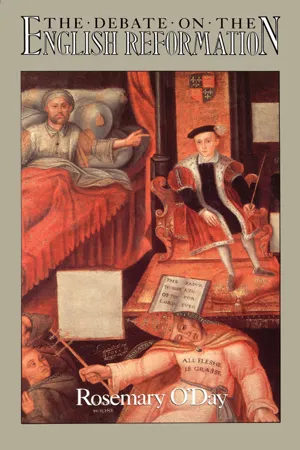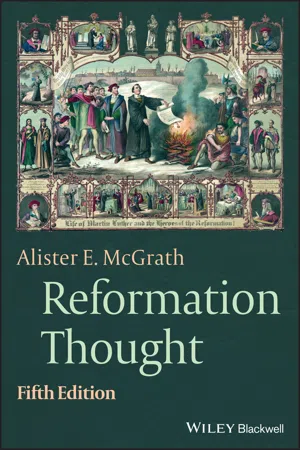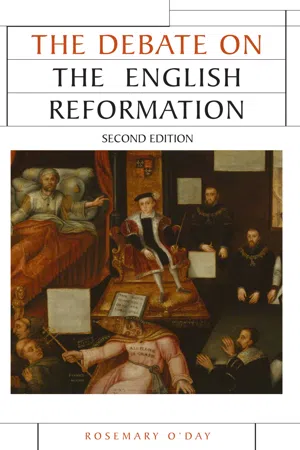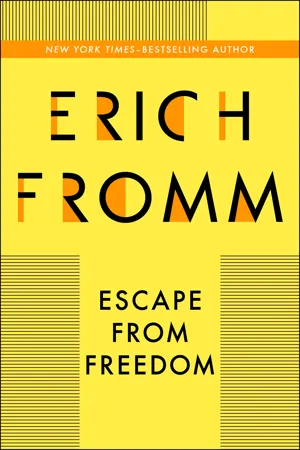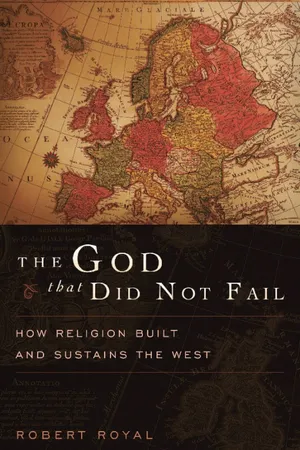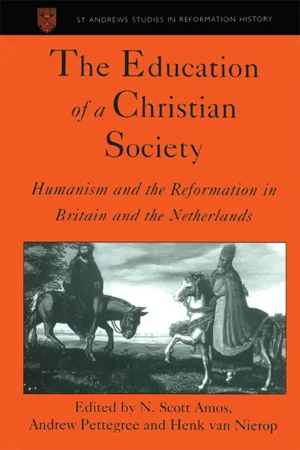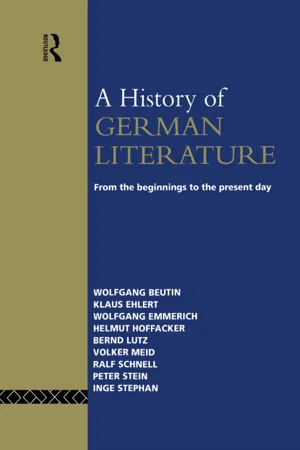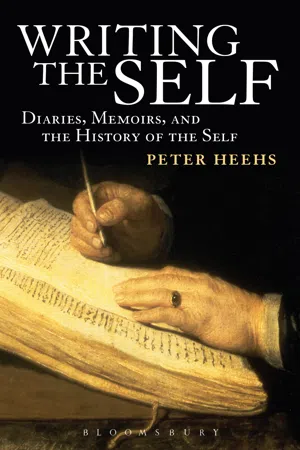History
Humanism and the Reformation
Humanism and the Reformation were two influential movements during the Renaissance. Humanism emphasized the value of human potential and achievement, promoting education, literature, and the arts. The Reformation, led by figures like Martin Luther, sought to reform the Catholic Church and ultimately led to the establishment of Protestantism. Both movements had a significant impact on European society, culture, and religious practices.
Written by Perlego with AI-assistance
Related key terms
12 Key excerpts on "Humanism and the Reformation"
- eBook - ePub
- K. Durkin(Author)
- 2014(Publication Date)
- Palgrave Macmillan(Publisher)
and natural law (2004 [1961]: 53). In particular, he stresses the role of the Christian sects and mystics who argued for a return to Christ’s teachings: Thomism, the Cabbalists, Joachim of Fiore, and Meister Eckhart, among others. He also stresses the importance of the Reformation as giving repeated impetus to the historical liberation of man, particularly within the pre- and post-Reformation sects. Crucially, although Fromm reiterates that the failure of these movements in the thirteenth century meant that the short period of genuine Christianity ended and Europe returned to its paganism, the humanistic idea was not lost. In fact, this union of Greco-Roman and Judaeo-Christian concerns, which contained the basic idea, constituted something new that grew to fruition in Europe over course of the next one thousand years, giving birth to humanism as we recognize it and to the greatest flourishing of its central idea.This development is evident in what Fromm describes as the fifth stage, the move to “modern” society and, in particular, the changes brought into existence during the Renaissance and the Enlightenment periods. In speaking of this stage, Fromm rephrases Burckhardt’s famous formulation of the Renaissance as the “discovery” of the individual: “Perhaps instead of saying ‘discovery,’ one should more precisely say ‘re-discovery,’ since it is the rebirth of much that Greek and Roman antiquity felt about man and nature” (2005: 19). In fact, Fromm praises the Renaissance as the flowering of ideas unheard of since the Middle Ages, where the idea of human dignity, the unity of the human race, and of universal political and religious unity found “unencumbered expression” (2009 [1976]: 118). Renaissance man, for Fromm, giving birth to a new scientific attitude, becomes more fully aware of his powers and begins to free himself from the shackles of nature, developing a new attitude toward life as a whole. In the subsequent centuries, this new attitude toward life leads to a radically new understanding of the world, and, in the seventeenth and eighteenth centuries, the new humanism reaches its apogee: “Western thought centered on man, on humanity, and on humaneness” (2005: 20). Here, first of all in Renaissance humanism, humanitas - eBook - ePub
God's Philosophers
How the Medieval World Laid the Foundations of Modern Science
- James Hannam(Author)
- 2009(Publication Date)
- Icon Books(Publisher)
CHAPTER 14 Humanism and the ReformationBy the time Constantinople fell in 1453, the Pope was back in Rome after his sojourn in Avignon and better still, there was only one of him. However, the popes of the late fifteenth century were among the worst in history. They battled for secular power in Italy while using the wealth of the Church to fund lavish parties and building projects. The Vatican was a den of vice and corruption. On the plus side, the profligacy of the papacy and the rest of the Italian nobility provided the funds necessary to produce the artistic jewels of quattrocento Italy as each city tried to outdo the others in flamboyance. The best painters, sculptors and architects were held in high esteem and the need to produce more and more remarkable art drove innovation. Filippo Brunelleschi (1377–1446) designed the spectacular dome that tops Florence’s cathedral and was the first to codify the technique of perspective.1 Painting was further improved when vegetable oil became the medium of choice for artists. Oil paints allowed for a greater depth of colour than the earlier egg-based pigments. All these innovations resulted in art so dazzling that later generations dubbed the entire period the Renaissance.The Rise of Humanism
As we have already seen, historians have a tendency to give value-laden names to historical periods. These help to fix popular perceptions of the period in question. And, if the name catches on, other historians co-opt it to their own periods. We have met two renaissances so far, the Carolingian renaissance under the Emperor Charlemagne and the resurgence of scholarship during the twelfth century. The period that everybody means by ‘the’ Renaissance lasted roughly from the late fourteenth to the early sixteenth century. The French historian Jules Michelet (1798–1874) first coined the term in the 1850s, but it took Jacob Burckhardt (1818–97) from Switzerland to turn it into common currency in his seminal work The Civilisation of the Renaissance in Italy (1860).2 Michelet and Burckhardt both strongly contrasted the rebirth of culture in the fifteenth century with medieval stagnation. As Burckhardt claimed: ‘In the Middle Ages, both sides of the human consciousness lay dreaming or half awake beneath a common veil.’3 - eBook - ePub
- Rosemary O'Day(Author)
- 2003(Publication Date)
- Routledge(Publisher)
Chapter 6The Reformation and the people
In the twentieth century, and particularly since 1960, the English Reformation has become prey to the new history . Historians, exhibiting their acquaintance with the methodologies of psychohistory, sociology, anthropology, demography, linguistics and economics have determined to write histoire totale . For this reason, it is often difficult to determine what are works of, strictly speaking, Reformation history at all and what are works of purely secular significance. Of course, the longstanding, if easily challenged, view that the Reformation was but the religious aspect of the Renaissance movement has always stressed the necessity for the religious historian to examine the Reformation in its context. That sixteenth-century intellectual life was imbued with religion is now a truism: every school student knows that God could not be left out of politics; that the clergy dominated education; that moral discipline was administered by the church courts; that the family was itself a ‘church’. But now something has been added – an awareness that religion itself has a sociological, a psychological and an economic dimension. Concepts such as ‘social control’, ‘professionalization’, ‘social mobility’, ‘class warfare’, ‘bureaucratization’, ‘capitalism’, ‘protoindustrialization’ are bandied about. The historians, products of an age which if not anti-religious is certainly a-religious, approach the history of the Reformation in a less credulous spirit than did their predecessors. Indeed, some regard with incredulity any suggestion that ‘man’ could possibly have a pure, unmixed belief in the godhead; surely his economic interests, his upbringing, his ambition must have been the motivating force in his life? Marx, Weber, Freud – their ghosts stalk the land of the new Reformation history. The theories as well as the techniques of other disciplines are used.The recent historiography of the Reformation is complicated. Of course, there is one level on which it can be made to look simple (Haigh 1982, 995–1007). The dispute over the causes - eBook - ePub
Reformation Thought
An Introduction
- Alister E. McGrath(Author)
- 2021(Publication Date)
- Wiley-Blackwell(Publisher)
The observation that the word “humanism” dates from long after the origins of the Renaissance suggests that Renaissance writers themselves did not recognize the existence of a common outlook or world-view known by this name. Modern readers tend to assume that “humanists” were individuals who subscribed to a common body of beliefs, attitudes, and values known as “humanism,” in much the same way as Marxists are individuals who subscribe to Marxism. Yet there is little historical evidence for this assumption. As we shall see, it proves remarkably difficult to define what this common body of beliefs, attitudes, and values was. The evidence points to the existence of many intellectuals who considered themselves to be “humanists,” but not that these shared some common intellectual framework known as “humanism.”Yet the term is used widely in Renaissance and Reformation studies, often with an irritating degree of fluidity. What is meant by the term “humanism”? In the recent past, two major lines of interpretation of the movement were predominant. First, humanism was viewed as a movement devoted to classical scholarship and philology. Second, humanism was the new philosophy of the Renaissance. We shall consider each of these two theories in what follows. As will become clear, both these interpretations of humanism have significant shortcomings.Classical Scholarship and Philology
One of the most distinctive features of the Renaissance is the rise of interest in classical scholarship, generally reflecting the assumption that such classical works had the capacity to enrich contemporary culture. “Grammar Schools” were initially established to ensure that students had easy access to Latin, which had become the cosmopolitan language of the western European cultural and academic elite of the Middle Ages; many of these schools later expanded their curriculum to include classical Greek. The Greek and Latin classics thus came to be widely studied in their original languages.Although some earlier studies suggested that humanism originated outside a university context, the evidence now available points unquestionably to a close link between humanism and the universities of northern Italy. It might therefore seem that humanism could be seen simply as a scholarly movement devoted to the study of the classical period. This, however, would be to overlook the question of why the humanists wished to study the classics in the first place. The evidence available makes it clear that such study was regarded as a means to an end, rather than an end in itself - eBook - ePub
The Debate on the English Reformation
Second edition
- Rosemary O'Day(Author)
- 2015(Publication Date)
- Manchester University Press(Publisher)
6 The Reformation and the people: discovery Introduction In the twentieth century, and particularly from 1960 to c. 1985, the English Reformation became prey to the new history. 1 Historians, exhibiting their acquaintance with the methodologies of psychohistory, sociology, anthropology, demography, linguistics and economics determined to write histoire totale. For this reason, it is often difficult to determine what were works of, strictly speaking, Reformation history at all and what were works of purely secular significance. Of course, the long-standing, if easily challenged, view that the Reformation was but the religious aspect of the Renaissance movement had always stressed the necessity for the religious historian to examine the Reformation in its context. That sixteenth-century intellectual life was imbued with religion was by the 1960s a truism: every school student then knew that God could not be left out of politics, that the clergy dominated education, that moral discipline was administered by the Church courts, and that the family was itself a ‘church’. But now something was added – an awareness that religion itself has a sociological, a psychological and an economic dimension. Concepts such as ‘social control’, ‘professionalization’, ‘social mobility’, ‘class warfare’, ‘bureaucratization’, ‘capitalism’, ‘protoindustrialization’ were bandied about. The historians, products of an age which, if not anti-religious, was certainly a-religious, approached the history of the Reformation in a less credulous spirit than did their predecessors. Indeed, some regarded with incredulity any suggestion that ‘man’ could possibly have a pure, unmixed belief in the godhead; surely his economic interests, his upbringing, his ambition must have been the motivating force in his life? Marx, Weber, Freud – their ghosts stalked the land of the new Reformation history of the 1960s, 1970s and 1980s. The theories as well as the techniques of other disciplines were used - eBook - ePub
- Charles G. Nauert(Author)
- 2023(Publication Date)
- Routledge(Publisher)
XRethinking “Christian Humanism”*“Christian Humanism!” Paul Oskar Kristeller, one of the founders of the Renaissance Society of America, was cool to the use of this phrase. He liked to keep the concept of Renaissance humanism simple and unencumbered by ideological or speculative considerations. He pointed out the obvious fact that all humanists during the Renaissance were Christians. Yet Kristeller did admit that the term might be used to define a subtype consisting of “those scholars who explicitly discussed religious or theological problems in all or some of their writings.”1 He still construed the term narrowly, excluding professional theologians like Aquinas or Luther but including not only Erasmus, Bude, More, and Hooker but also Calvin, Melanchthon, and many post-Reformation Jesuits. Yet Kristeller’s definition is too cautious. This essay will assume that “Christian humanists” not only discussed religious or theological issues but also explicitly made a connection between their humanistic teaching and scholarship on classical languages and literature, on the one hand, and on the other hand, their study of ancient Christianity, including the Bible and the Church Fathers. Even more important, they associated their scholarly work (classical as well as biblical and patristic) with a determination to bring about a spiritual renewal and institutional reform of Christian society. That connection between their scholarly efforts and their longing for spiritual and institutional renewal is the specific characteristic that distinguishes “Christian humanists” as a group from other humanists who just happened to be religious.By 1500, the culture of Renaissance Italy had begun to exert a powerful influence on Europe north of the Alps. Italian humanism passed along to northern Europe many achievements. One was linguistic: a more classical style of Latin and mastery of two languages, Greek and Hebrew, that had been little known in medieval Latin Christendom. Along with the languages came greater access to classical literature. By 1500, most of the major Latin authors had been made available in print. A century later, [p. 156] most of Greek classical and patristic literature had also been published, much of it in both Greek and Latin. In addition, a considerable body of classical literature had been published in vernacular translations. Even more important than such tangible influence, however, was the concept of Renaissance (cultural rebirth) itself, for humanists from the time of Petrarch (1304–74) had developed a characteristic outlook on the history of Europe and their own place in it. That view of history dismissed the medieval centuries as “barbarous” and professed a sublime if somewhat vague confidence that ancient civilization could be restored through the humanists’ own efforts to rediscover the heritage of Antiquity.2 - eBook - ePub
The Genesis of Science
How the Christian Middle Ages Launched the Scientific Revolution
- James Hannam(Author)
- 2011(Publication Date)
- Regnery(Publisher)
CHAPTER FOURTEENHumanism and the ReformationBy the time Constantinople fell in 1453, the pope was back in Rome after his sojourn in Avignon and better still, there was only one of him. However, the popes of the late fifteenth century were among the worst in history. They battled for secular power in Italy while using the wealth of the Church to fund lavish parties and building projects. The Vatican was a den of vice and corruption. On the plus side, the profligacy of the papacy and the rest of the Italian nobility provided the funds necessary to produce the artistic jewels of quattrocento Italy as each city tried to outdo the others in flamboyance. The best painters, sculptors, and architects were held in high esteem, and the need to produce more and more remarkable art drove innovation. Filippo Brunelleschi (1377–1446) designed the spectacular dome that tops Florence’s cathedral and was the first to codify the technique of perspective.1 Painting was further improved when vegetable oil became the medium of choice for artists. Oil paints allowed for a greater depth of color than the earlier egg-based pigments. All these innovations resulted in art so dazzling that later generations dubbed the entire period the Renaissance.THE RISE OF HUMANISM
As we have already seen, historians have a tendency to give valueladen names to historical periods. These help to fix popular perceptions of the period in question. And, if the name catches on, other historians co-opt it to their own periods. We have met two renaissances so far, the Carolingian renaissance under the Emperor Charlemagne and the resurgence of scholarship during the twelfth century. The period that everybody means by “the” Renaissance lasted roughly from the late fourteenth to the early sixteenth century. The French historian Jules Michelet (1798–1874) first coined the term in the 1850s, but it took Jacob Burckhardt (1818–1897) from Switzerland to turn it into common currency in his seminal work The Civilization of the Renaissance in Italy (1860).2 Michelet and Burckhardt both strongly contrasted the rebirth of culture in the fifteenth century with medieval stagnation. As Burckhardt claimed: “In the Middle Ages, both sides of the human consciousness lay dreaming or half awake beneath a common veil.”3 - eBook - ePub
- Erich Fromm(Author)
- 2013(Publication Date)
- Open Road Media(Publisher)
op. cit., p. 139.), characteristic of the individual of the Renaissance and not present, at least in the same intensity, in the member of the medieval social structure: his passionate craving for fame. If the meaning of life has become doubtful, if one’s relations to others and to oneself do not offer security, then fame is one means to silence one’s doubts. It has a function to be compared with that of the Egyptian pyramids or the Christian faith in immortality: it elevates one’s individual life from its limitations and instability to the plane of indestructibility; if one’s name is known to one’s contemporaries and if one can hope that it will last for centuries, then one’s life has meaning and significance by this very reflection of it in the judgments of others. It is obvious that this solution of individual insecurity was only possible for a social group whose members possessed the actual means of gaining fame. It was not a solution which was possible for the powerless masses in that same culture nor one which we shall find in the urban middle class that was the backbone of the Reformation.We started with the discussion of the Renaissance because this period is the beginning of modern individualism and also because the work done by historians of this period throws some light on the very factors which are significant for the main process which this study analyzes, namely the emergence of man from a pre-individualistic existence to one in which he has full awareness of himself as a separate entity. But in spite of the fact that the ideas of the Renaissance were not without influence on the further development of European thinking, the essential roots of modern capitalism, its economic structure and its spirit, are not to be found in the Italian culture of the late Middle Ages, but in the economic and social situation of Central and Western Europe and in the doctrines of Luther and Calvin.The main difference between the two cultures is this: the Renaissance period represented a comparatively high development of commercial and industrial capitalism; it was a society in which a small group of wealthy and powerful individuals ruled and formed the social basis for the philosophers and artists who expressed the spirit of this culture. The Reformation, on the other hand, was essentially a religion of the urban middle and lower classes, and of the peasants. Germany, too, had its wealthy businessmen, like the Fuggers, but they were not the ones to whom the new religious doctrines appealed, nor were they the main basis from which modern capitalism developed. As Max Weber has shown, it was the urban middle class which became the backbone of modern capitalistic development in the Western World.19 According to the entirely different social background of both movements we must expect the spirit of the Renaissance and that of the Reformation to be different.20 - eBook - ePub
The God That Did Not Fail
How Religion Built and Sustains the West
- Robert Royal(Author)
- 2006(Publication Date)
- Encounter Books(Publisher)
3There were various continuities between the medieval and the Renaissance ideas of a humanist, but notable differences as well.4 To begin with, since theology, law, medicine, and the sciences began to develop as professions and distinct university faculties, they did not exactly address the more general interests of the humanists. These fell into what had been called the studia humanitatis (“studies of humanity”) in antiquity. Medieval universities had proposed a list of basic studies divided into the trivium (grammar, dialectic, rhetoric) and the quadrivium (arithmetic, geometry, astronomy, music), but the schools, libraries, and universities dedicated to Renaissance humanism proposed five areas of study: grammar, rhetoric, history, poetry, and moral philosophy. As this bare list indicates, humanism was less concerned with theoretical speculation than with practical and moral questions, but not to the exclusion of religious matters.The main figures of the early Italian Renaissance clearly show as much, though there is naturally greater or lesser engagement with spiritual questions from one of them to another. What this means can be seen quite early, even in a precursor such as Francesco Petrarca (English: Petrarch, 1304-1374). Petrarch was religiously an Augustinian in the sense that—like the Franciscans, the Ockhamists, Luther, and others—he did not have much interest in the kind of theoretical theology, usually based in Aristotle, that was common in the Middle Ages. Petrarch is most famous for work that he himself regarded as of small value: the love sonnets and lyric poetry he composed in Italian. His more serious work, as he saw it, lay in the composition of moral treatises, letters, and even an epic poem, all in Latin, intended literally to resurrect ancient styles once mastered by Seneca, Cicero, and Virgil. As often happens in history, however, this effort at revival had the exact opposite of its intended effect. The rejection of the Latin then in use in favor of a classical model had the effect not of reviving the classical world, but of ensuring that Latin became a dead language, since the forms enthusiastically recovered and imitated from the ancient pagans did not correspond with Renaissance life.q - eBook - ePub
The Education of a Christian Society
Humanism and the Reformation in Britain and the Netherlands
- N. Scott Amos, Andrew Pettegree(Authors)
- 2017(Publication Date)
- Routledge(Publisher)
The reluctance to take risks to support Luther, for instance, probably owes as much to Erasmus’s terror of risking his hard-won wealth and social position late in life as to the high-minded commitment to church unity that he proclaimed (and that his scathing criticisms of the Church had done so much to diminish). 33 To the extent that Erasmus’s career is in some respects a triumph of image management, one might ask the same probing questions about humanism. In the sixteenth-century clash of ideas humanism was very definitely on the side of the angels, and this is not just to reflect the bias of later progress-oriented history writing. Even in the sixteenth century, to denounce the new philological techniques and philosophical assumptions of the humanist agenda was to risk opprobrium and ridicule. 34 In this respect Richard Rex’s evocation of a lively appreciation for the new learning among English conservatives during the reign of Henry VIII is a necessary corrective against the easy assumption linking humanism and reform. It was perfectly possible to revel in the new educational opportunities of the sixteenth century, while holding fast to traditional confessional loyalties. 35 What then was the essential core of the humanist agenda? As Karin Tilmans points out in this volume, education was vital to humanism, and this makes a useful point of departure for our discussion. 36 But how important was humanism to the circulation of ideas? Was it in fact too élite a movement to play a substantial part in the intellectual interchange of an age where population movements at all levels of society made the control of information well-nigh impossible? The essays in this volume suggest not: indeed, it is clear that humanism and humanists remained very firmly rooted in the political structures of the age. Humanists, for all their elaborate praise of the literary arts, clearly also had a very practical sense of where actual political power lay in society - eBook - ePub
A History of German Literature
From the Beginnings to the Present Day
- Wolfgang Beutin, Klaus Ehlert, Wolfgang Emmerich, Helmut Hoffacker, Bernd Lutz, Volker Meid, Ralf Schnell, Peter Stein, Inge Stephan, Claire Krojzl(Authors)
- 2005(Publication Date)
- Routledge(Publisher)
The beginning of the Italian Renaissance is generally set in the thirteenth century, with the end of Hohenstaufen rule. This created a power vacuum in which the towns and a new urban culture could begin to develop. The first stirrings of Renaissance Humanism in Germany were discernible around 1400, and the first signs of the Humanist movement in the second half of the fifteenth century. Among the innovations evident prior to the shift towards the Renaissance in the empire, some of those concerning world-view and art in particular may be mentioned here.Mysticism and the official Church
Late medieval German mysticism coincides with the first high points in the Italian Renaissance. Research has revealed links between this mysticism and Italian poetry, such as those between Dante and the mysticism of nuns in Helfta (near Magdeburg). Like Renaissance Humanism the unio mystica, the sought-after union with God in innermost saintliness, the soul of the believer, was disquieting to the clergy. The official Church and its hierarchy found itself threatened with superfluousness, a danger that was not lost on them (hence the Inquisition proceedings against and conviction of the most important of the German mystics, Meister Eckhart, in 1329). With the devotio moderna the fourteenth century saw the rise of a new form of piety, documented in literary form in the work De imitatione Christi by Thomas à Kempis. Printed in 1470, it remains one of the most widely disseminated devotional books in the Christian world next to the Bible itself. Erasmus of Rotterdam, later regarded as the leading figure of northern European Humanism, gained his knowledge of classics and Humanism at the schools of the ‘Brothers of the Common Life’. New developments in the arts, particularly in architecture and painting (mural painting, altar-pieces and the appearance of panel painting), became known by the art-historical terms ‘Gothic’ or ‘Late Gothic’. A special development in Western Europe (France, the Netherlands and England) was ars nova, involving an attempt to adopt and cultivate ancient subject-matter, as well as nature studies (hence the development inter alia - eBook - ePub
Writing the Self
Diaries, Memoirs, and the History of the Self
- Peter Heehs(Author)
- 2013(Publication Date)
- Bloomsbury Academic(Publisher)
5Pico’s Oration , often called the manifesto of Renaissance humanism, was also an early articulation of Renaissance individualism. During the Middle Ages, according to nineteenth-century Swiss historian Jacob Burckhardt, “man was conscious of himself only as a member of a race, people, party, family, or corporation – only through some general category.” But in Renaissance Italy, “man became a spiritual individual ,” and “recognized himself as such.”6 More recent writers, for example Stephen Greenblatt, have questioned some of Burckhardt’s conclusions; but even Greenblatt concedes that the social conditions of fourteenth-century Italy “fostered a radical change in consciousness.” People “were cut off from established forms of identity and forced by their relation to power to fashion a new sense of themselves and their world.”7The changes in the way Renaissance people viewed the world is evident in the art of the period. The invention of perspective allowed painters to present spatial relations in a realistic manner. Portraitists depicted their subjects as specific, recognizable persons and not as idealized types. Renaissance literature displayed a remarkable increase in the subjective point of view. The artist Benvenuto Cellini (1500–71) wrote an autobiography in which he showed both the creative and the violent sides of his nature. To Burckhardt this book, while not introspective, “describes the whole man – not always willingly – with marvelous truth and completeness.”8Righteousness and Reform: Martin LutherIn 1519 a German monk named Martin Luther (1483–1546) sat in the tower of his monastery wrestling with a passage from Paul’s Epistle to the Romans . What, he thought, did the apostle mean by the “justice of God”? According to Luther’s teachers, the phrase meant the power to punish sinners and the unjust. But why did God threaten miserable sinners like Luther “with his justice and his wrath”? Terrified at the prospect of damnation, he meditated night and day on Paul’s words. Finally he realized that they had to be read along with another Biblical phrase: “The just person lives by faith.” God justifies sinners – declares them to be righteous – through an act of grace that is merited by faith alone. When he understood this, Luther wrote, “all at once I felt that I had been born again and entered into paradise itself through open gates.” He saw “the whole of Scripture in a different light,” and came to love the words “justice of God” as vehemently as he had hated them before.9
Index pages curate the most relevant extracts from our library of academic textbooks. They’ve been created using an in-house natural language model (NLM), each adding context and meaning to key research topics.


